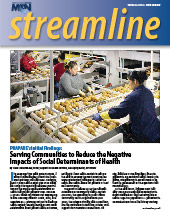
PRAPARE Data
Through PRAPARE, health centers ask standardized questions to determine a patient’s social determinant of health risk. Here is an abbreviated list of the 21 questions asked; within the PRAPARE format, each question is followed by a set of multiple-choice answers. Some questions are edited for brevity or clarity.
1. Are you Hispanic or Latino?
2. Which race(s) are you? Check all that apply.
3. At any point in the past two years, has seasonal or migrant farm work been your or your family’s main source of income?
4. Have you been discharged from the armed forces of the United States?
5. What languages are you most comfortable speaking?
6. How many family members, including yourself, do you currently live with?
7. What is your housing situation today?
8. Are you worried about losing your housing?
9. What is your current address?
10. What is the highest level of school that you have finished?
11. What is your current work situation?
12. What is your main insurance?
13. During the past year, what was the total combined income for you and the family members you live with?
14. In the past year, have you or any family members you live with been unable to get any of the following when it was really needed? (Answers include food, utilities, medicine or health care, phone, clothing, and child care.)
15. Has lack of transportation kept you from medical appointments, meetings, work, or from getting things you needed for daily living?
16. How often do you see or talk to people that you care about and feel close to?
17. How stressed are you?
18. In the past year, have you spent more than two nights in a row in a jail, prison, detention center, or juvenile correctional facility?
19. Are you a refugee?
20. Do you feel physically and emotionally safe where you currently live?
21. In the past year, have you been afraid of your partner or ex-partner?
The National Association of Community Health Centers (NACHC) website (www.nachc.org/prapare) has the complete list of questions and offers an implementation action toolkit to help health centers prepare to integrate the data collection system into their electronic medical record.
It’s been over two years since PRAPARE, a national standardized patient risk assessment protocol, was launched. Currently, about 1,000 health center sites in six states are using it to collect standardized information on the myriad social determinants of health that impact patients’ lives. PRAPARE — which stands for Protocol for Responding to and Assessing Patients’ Assets, Risks, and Experiences — promises not just to advance health centers’ understanding of how social determinants affect patient health outcomes, but also to allow health centers to lean on the data to develop the most effective and useful intervention strategies to better the health and health access for patients in their local community.
The effort is headed up by the National Association of Community Health Centers (NACHC), the Association of Asian Pacific Community Health Organizations (AAPCHO), the Oregon Primary Care Association, and the Institute for Alternative Futures, with support from numerous foundations. It’s free, available in five languages, and integrates with six electronic health record programs. Integration with several more is on the way. (See sidebar for the questions that PRAPARE asks.)
As the data roll in, analyses show that early PRAPARE findings are consistent with recent literature on social determinants of health: high-risk populations — patients with co-morbidities or who are actively working with a chronic disease management team — had a higher social determinant risk score, compared to the low-risk population. In addition to managing their health concerns, these patients must confront overlapping pressures that may be additionally affecting their health including lack of transportation, lower income, insecure housing, low educational levels, and limited English proficiency. (See sidebar on early data results.)
Michelle Jester, NACHC’s research manager, says health centers are acting on the data. “In a lot of cases, PRAPARE is identifying new needs that health centers did not realize they had,” she said, and cited several examples: at a health center in California, patients indicated via PRAPARE that a lack of childcare was limiting their ability to make and keep appointments, so the health center partnered with daycare facilities and began to rethink onsite childcare. Another health center discovered that transportation was a significant issue, so they increased their transportation services, mobile clinics, and other in-community outreach programs. Several health centers, Jester noted, are combining PRAPARE data with outcome and utilization data to develop patient risk scores. “Some [health centers] are geo-mapping the data, and mapping where there are certain areas with certain needs,” identifying food deserts, a lack of transportation, or other barriers. Health centers have been using that data to advocate for more services in those regions, Jester said, for example, by pushing local or regional transportation authorities to expand in an area that lacks transportation.
The PRAPARE data are building a larger picture of patients’ needs that is mobilizing health centers to partner with community action agencies, nonprofits, and other community groups to share information and resources to best address patients’ needs as a whole community. “Head Start might track truancy, which a health center wouldn’t be tracking, and so they have different data sets that can add value in having that full picture of a patient,” Jester noted. Health centers serving agricultural workers will have better data on how many agricultural workers or family members attend their clinics. Additional questions around housing and food security are helping health centers adjust their programs for their agricultural workers to better serve their specific needs. In addition, health centers using PRAPARE are now populating a nationwide set of data on the specific barriers that agricultural workers are facing, Jester said. Learn more about PRAPARE, and access implementation tools, webinars, and other resources at NACHC’s PRAPARE page: www.nachc.org/prapare.
Health Network and PRAPARE
In 2016, just as PRAPARE was set to launch, Migrant Clinicians Network was beginning to develop its new database to better serve patients enrolled in Health Network, MCN’s bridge case management program. Over the course of the following year, MCN configured the new database to allow for the integration of PRAPARE data, in which one health center’s PRAPARE data can be transferred to the next health center, as a mobile patient moves.
“When we started thinking about that data and [Health Network] case management work, so much of case management isn’t just ‘are you taking your medication every day?’ It’s more about, ‘How can I help you access care and manage your health in general?’” explained Anna Gard, RN, who assisted MCN in the development of the new database. “One piece of this is: ‘Let me help you find a health center.’ But the larger pieces around effective case management are, ‘How are you going to get there? Is there public transportation? How are you going to pick up your medications if you live in a hostile community and you’re afraid of leaving the house?’ PRAPARE gives a structured format to capture [these] data, in a form that’s been tested and validated.”
As more health centers provide case management and chronic care management to address the social determinants of health, Gard noted, integration of the PRAPARE data with Health Network, a virtual case management, seemed to make sense. Now, the Health Network team is working to fit PRAPARE into their own workflow.
Saul Delgado, Health Network Data Specialist, who has been integral in building and launching Health Network’s new case management system, notes that asking such personal questions over the phone, when a patient doesn’t have transferrable PRAPARE data from a previous health center, can be challenging. “When we call, the patient doesn’t know you. They’re very scared to answer these kinds of personal questions, whereas when you go the clinic, you at least see the nurse or case worker face-to-face,” he explained. But he recognizes the utility of the data, and has developed the PRAPARE data screens within the database to be easily accessed from the main patient information screen. With drop-down menus, Health Network Associates can populate the information they hear from patients, like how many people live with them in their household, or if they’re worried about losing their home. The information, either attained from a previous health center or inputted by a Health Network Associate, will be transferred when the mobile patient gets to his or her next destination, just as the basic medical records do.
“Health centers are doing more to integrate social and behavioral determinants of health, and we’re recognizing that all of those things have to be integrated with care management. So we’re on the forefront,” Gard concluded.
Early Findings of PRAPARE DATA
The data of roughly 7,000 patients were analyzed, grouping patients according to their risk factor (in which a “high-risk” patient is one with co-morbidities or who are actively working with a chronic disease management team) and determining how many barriers to health patients have faced (termed “social determinant risks”). Among high-risk patients, 20 percent said that lack of transportation inhibited their ability to get to medical appointments, work, or other basic important obligations. Other common social determinant risks included limited English proficiency (32 percent), less than a high school education (32 percent), lack of insurance (25 percent), experiencing high to medium-high stress (24 percent) and unemployment (18 percent). The most common social determinant asset was social integration, with upwards of half of patients seeing those they care about five or more times a week.
In line with recent research, the early PRAPARE data indicated that high-risk patients were primarily people of color, with just 38 percent of high-risk patients identifying as white versus 68 percent white patients in the general population.
Seven health centers looked specifically at whether there was a correlation between hypertension and patients facing a higher number of social determinant risks. The conclusion found a “moderately strong relationship,” showing that as the score of the number of social determinant risks went up, so did the likelihood of that patient experiencing hypertension. Preliminary analysis has also found that those with stress were far more likely to have uncontrolled hypertension.
The data were limited by not incorporating enabling services and other non-clinical interventions at the health center level that future data analyses will include. The PRAPARE data is now collecting standardized enabling service information through an “enabling services accountability project,” wherein each enabling service is categorized. PRAPARE provides an implementation packet that includes a handbook and toolkit to help health centers accurately code their enabling services.
Read this article in the Winter 2019 issue of Streamline here!
Sign up for our eNewsletter to receive bimonthly news from MCN, including announcements of the next Streamline.
